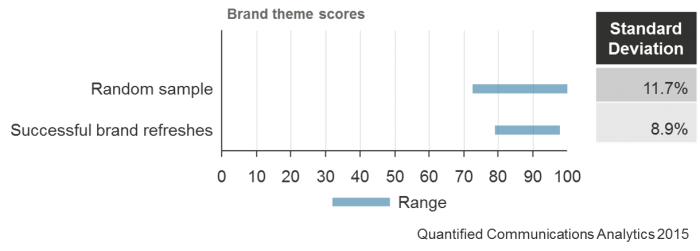Want to successfully refresh your brand identity? Best practices for brand messaging during a refresh

Even the best-known brands evolve. In order to stay relevant to their customers, companies often need to “refresh” their brands, which can be done in a number of ways: by updating their messaging, by creating a new logo, or by creating a new brand identity.
We wondered, how does a brand refresh affect brand language messaging? When companies choose to refresh their brand, how can they ensure marketing and corporate communications success?
To find out, we measured the corporate and marketing communications from six Fortune 500 companies included on Business Insider’s list of Successful brand refresh campaigns to analyze the consistency of their communications.
Our analysis:
Our dataset included hundreds of messages from six publicly traded companies such as UPS, McDonald’s, and Walmart in the years surrounding their brand refresh as well as a random sample of corporate messaging in our database.
For our measurement, we used our natural language processing and linguistic mapping technologies, where we’ve developed a way to measure how a company describes its brand. For example, does a company tout its luxurious products (think Lexus); or does it focus on communicating its affordable pricing (Walmart)?
The analytics compared the consistency of messaging for the top five brand themes used by each company, by analyzing the standard deviations for each company’s top five brand themes in two groups:
- Companies who underwent a successful brand identity refresh
- A random sample of branded company communications
What we found:
The companies who most successfully refreshed their brand kept their brand messaging 31% more consistent than the average company.
In other words, as these six companies underwent a brand refresh, their brand messaging remained highly consistent, especially when they were communicating themes core to their business.

What it means:
Surprisingly, the companies that were changing their brand in some capacity saw smaller variations in their brand messaging than a random sample of corporations from our database. So companies managed to refresh their brands while remaining highly consistent in conveying the core themes which customers had come to expect from them.
Academic studies support this finding by showing that message consistency builds corporate credibility. If a brand begins to communicate in a way that deviates greatly from what consumers expect to hear, the consumers may begin to lose confidence in that brand.
Conclusion:
Based on our brand messaging measurement study, when a company decides to refresh its brand, it forces a company to tighten up its messaging and make it more consistent.
Companies need a way to know if they are remaining consistent in their communications even as their brands undergo changes. An objective communications analysis of corporate communication can help companies track how consistently they are communicating across different channels, as well as over time.